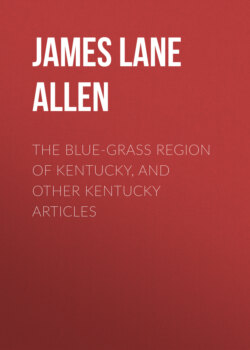Читать книгу The Blue-Grass Region of Kentucky, and Other Kentucky Articles - James Lane Allen - Страница 8
На сайте Литреса книга снята с продажи.
III
ОглавлениеTable of Contents
But the ideal landscape of daily life must not be merely beautiful: it should be useful. With what may not the fertility of this region be compared? With the valleys of the Schuylkill, the Shenandoah, and the Genesee; with the richest lands of Lombardy [20] and Belgium; with the most fertile districts of England. The evidences of this fertility are everywhere. Nature, even in those places where she has been forced for nearly a hundred years to bear much at the hands of a not always judicious agriculture, unceasingly struggles to cover herself with bushes of all sorts and nameless annual weeds and grasses. Even the blue-grass contends in vain for complete possession of its freehold. One is forced to note, even though without sentiment, the rich pageant of transitory wild bloom that will force a passage for itself over the landscape: firmaments of golden dandelions in the lawns; vast beds of violets, gray and blue, in dim glades; patches of flaunting sunflowers along the road-sides; purple thistles; and, of deeper purple still and far denser growth, beautiful ironweed in the woods; with many clumps of alder bloom, and fast-extending patches of perennial blackberry, and groups of delicate May-apples, and whole fields of dog-fennel and golden-rod. And why mention indomitable dock and gigantic poke, burrs and plenteous nightshade, and mullein and plantain, with dusty gray-green ragweed and thrifty fox-tail?—an innumerable company.
Maize, pumpkins, and beans grow together in a field—a triple crop. Nature perfects them all, yet must do more. Scarce have the ploughs left the furrows before there springs up a varied wild growth, and a fourth crop, morning-glories, festoon the tall [21] [22] [23] tassels of the Indian corn ere the knife can be laid against the stalk. Harvest fields usually have their stubble well hidden by a rich, deep aftermath. Garden patches, for all that hoe and rake can do, commonly look at last like spots given over to weeds and grasses. Sidewalks quickly lose their borders. Pavements would soon disappear from sight; the winding of a distant stream through the fields can be readily followed by the line of vegetation that rushes there to fight for life, from the minutest creeping vines to forest trees. Every neglected fence corner becomes an area for a fresh colony. Leave one of these sweet, humanized woodland pastures alone for a short period of years, it runs wild with a dense young natural forest; vines shoot up to the tops of the tallest trees, and then tumble over in green sprays on the heads of others.
CATTLE IN A BLUE-GRASS PASTURE.
A kind, true, patient, self-helpful soil if ever there was one! Some of these lands after being cultivated, not always scientifically, but always without artificial fertilizers, for more than three-quarters of a century, are now, if properly treated, equal in productiveness to the best farming lands of England. The farmer from one of these old fields will take two different crops in a season. He gets two cuttings of clover from a meadow, and has rich grazing left. A few counties have at a time produced three-fourths of the entire hemp product of the United States. The State itself has at different times stood first in [24] wheat and hemp and Indian corn and wool and tobacco and flax, although half its territory is covered with virgin forests. When lands under improper treatment have become impoverished, their productiveness has been restored, not by artificial fertilizers, but by simple rotation of crops, with nature's help. The soil rests on decomposable limestone, which annually gives up to it in solution all the essential mineral plant food that judicious agriculture needs.
Soil and air and climate—the entire aggregate of influences happily co-operative—make the finest grazing. The Kentucky horse has carried the reputation of the country into regions where even the people could never have made it known. Your expert in the breeding of thoroughbreds will tell you that the muscular fibre of the blue-grass animal is to that of the Pennsylvania-bred horses as silk to cotton, and the texture of his bone, compared with the latter's, as ivory beside pumice-stone. If taken to the Eastern States, in twelve generations he is no longer the same breed of horse. His blood fertilizes American stock the continent over. Jersey cattle brought here increase in size. Sires come to Kentucky to make themselves and their offspring famous.
The people themselves are a fecund race. Out of this State have gone more to enrich the citizenship of the nation than all the other States together have [25] been able to send into it. So at least your loyal-hearted Kentuckian looks at the rather delicate subject of inter-State migration. By actual measurement the Kentucky volunteers during the Civil War were found to surpass all others (except Tennesseeans) in height and weight, whether coming from the United States or various countries of Europe. But for the great-headed Scandinavians, they would have been first, also, in circumference around the forehead and occiput. Still, Kentucky has little or no literature.
HEMP FIELD.
One element that should be conspicuous in fertile countries does not strike the observer here—much beautiful water; no other State has a frontage of navigable rivers equal to that of Kentucky. But there are few limpid, lovely, smaller streams. Wonderful springs there are, and vast stores of water in the cavernous earth below; but the landscape lacks [26] the charm of this element—clear, rushing, musical, abundant. The watercourses, ever winding and graceful, are apt to be either swollen and turbid or insignificant; of late years the beds seem less full also—a change consequent, perhaps, upon the denudation of forest lands. In a dry season the historic Elkhorn seems little more than a ganglion of precarious pools.
